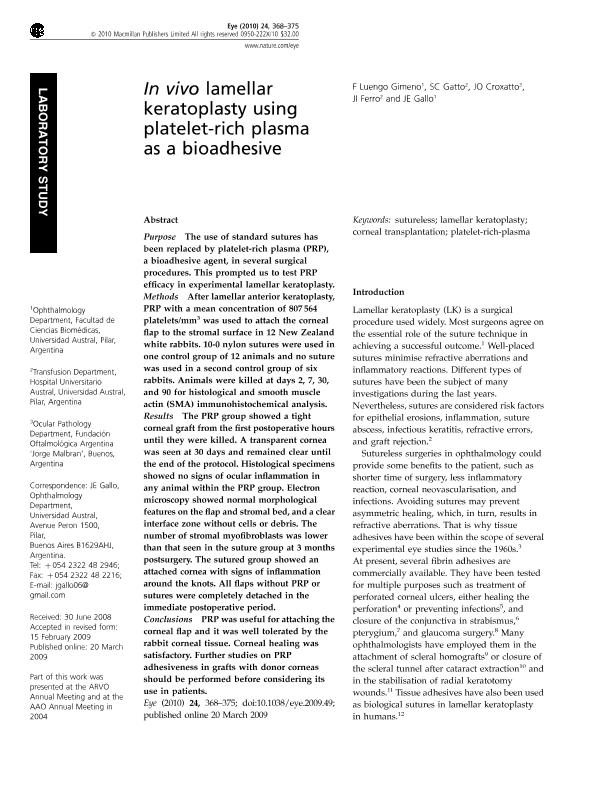Mostrar el registro sencillo del ítem
dc.contributor.author
Gimeno, F. Luengo
dc.contributor.author
Gatto, S. C.
dc.contributor.author
Croxatto, Juan Oscar

dc.contributor.author
Ferro, J. I.
dc.contributor.author
Gallo, Juan Eduardo Maria

dc.date.available
2020-01-30T18:26:25Z
dc.date.issued
2010-02
dc.identifier.citation
Gimeno, F. Luengo; Gatto, S. C.; Croxatto, Juan Oscar; Ferro, J. I.; Gallo, Juan Eduardo Maria; In vivo lamellar keratoplasty using platelet-rich plasma as a bioadhesive; Nature Publishing Group; Eye; 24; 2; 2-2010; 368-375
dc.identifier.issn
0950-222X
dc.identifier.uri
http://hdl.handle.net/11336/96253
dc.description.abstract
Purpose The use of standard sutures has been replaced by platelet-rich plasma (PRP), a bioadhesive agent, in several surgical procedures. This prompted us to test PRP efficacy in experimental lamellar keratoplasty. Methods After lamellar anterior keratoplasty, PRP with a mean concentration of 807 564 platelets/mm 3 was used to attach the corneal flap to the stromal surface in 12 New Zealand white rabbits. 10-0 nylon sutures were used in one control group of 12 animals and no suture was used in a second control group of six rabbits. Animals were killed at days 2, 7, 30, and 90 for histological and smooth muscle actin (SMA) immunohistochemical analysis. Results The PRP group showed a tight corneal graft from the first postoperative hours until they were killed. A transparent cornea was seen at 30 days and remained clear until the end of the protocol. Histological specimens showed no signs of ocular inflammation in any animal within the PRP group. Electron microscopy showed normal morphological features on the flap and stromal bed, and a clear interface zone without cells or debris. The number of stromal myofibroblasts was lower than that seen in the suture group at 3 months postsurgery. The sutured group showed an attached cornea with signs of inflammation around the knots. All flaps without PRP or sutures were completely detached in the immediate postoperative period. Conclusions PRP was useful for attaching the corneal flap and it was well tolerated by the rabbit corneal tissue. Corneal healing was satisfactory. Further studies on PRP adhesiveness in grafts with donor corneas should be performed before considering its use in patients.
dc.format
application/pdf
dc.language.iso
eng
dc.publisher
Nature Publishing Group

dc.rights
info:eu-repo/semantics/openAccess
dc.rights.uri
https://creativecommons.org/licenses/by-nc-sa/2.5/ar/
dc.subject
CORNEAL TRANSPLANTATION
dc.subject
LAMELLAR KERATOPLASTY
dc.subject
PLATELET-RICH-PLASMA
dc.subject
SUTURELESS
dc.subject.classification
Oftalmología

dc.subject.classification
Medicina Clínica

dc.subject.classification
CIENCIAS MÉDICAS Y DE LA SALUD

dc.subject.classification
Trasplantes

dc.subject.classification
Medicina Clínica

dc.subject.classification
CIENCIAS MÉDICAS Y DE LA SALUD

dc.title
In vivo lamellar keratoplasty using platelet-rich plasma as a bioadhesive
dc.type
info:eu-repo/semantics/article
dc.type
info:ar-repo/semantics/artículo
dc.type
info:eu-repo/semantics/publishedVersion
dc.date.updated
2020-01-29T15:41:26Z
dc.journal.volume
24
dc.journal.number
2
dc.journal.pagination
368-375
dc.journal.pais
Reino Unido

dc.journal.ciudad
Londres
dc.description.fil
Fil: Gimeno, F. Luengo. Universidad Austral; Argentina
dc.description.fil
Fil: Gatto, S. C.. Hospital Universitario Austral; Argentina
dc.description.fil
Fil: Croxatto, Juan Oscar. Fundación Oftalmología Argentina "J. Malbrán"; Argentina. Consejo Nacional de Investigaciones Científicas y Técnicas; Argentina
dc.description.fil
Fil: Ferro, J. I.. Hospital Universitario Austral; Argentina
dc.description.fil
Fil: Gallo, Juan Eduardo Maria. Consejo Nacional de Investigaciones Científicas y Técnicas; Argentina. Universidad Austral; Argentina
dc.journal.title
Eye

dc.relation.alternativeid
info:eu-repo/semantics/altIdentifier/doi/http://dx.doi.org/10.1038/eye.2009.49
dc.relation.alternativeid
info:eu-repo/semantics/altIdentifier/url/https://www.nature.com/articles/eye200949
Archivos asociados
